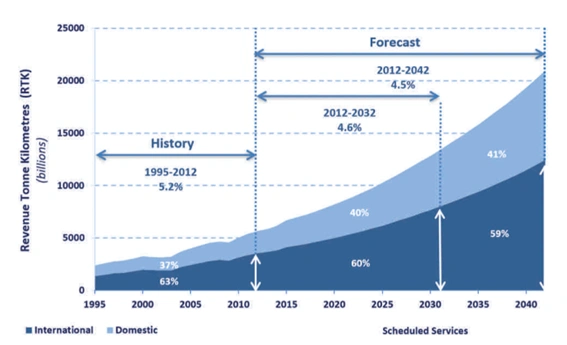31 Jul Factors influencing the future of Airport Development

Great cities of the past were built around ports and railway stations. But airports are arguably the most essential link to prosperity in today’s globalized world. Aviation catalyzes economic growth, enabling people and businesses to reach a global marketplace for goods and services and travel for work, leisure or education. A study of the impact of European airports found that a 10% increase in a country’s air connectivity was associated with a 0.5% increase in GDP per capita.
The airport will become the best-connected place in the city and a much more integral part of it. The keyword for sustainable airport development is multimodal. Airports will be hubs for city and regional links and mass transit of many kinds: high-speed rail, autonomous vehicles, hyper-loop, and drone taxis. As airports become quieter, cleaner and better connected by mass transit — and cities more crowded and congested — they suddenly present a much more exciting development opportunity.
In recent years, airports have become increasingly aware of the value of their location at the nexus of regional transportation networks. In the UK, Heathrow alone is estimated to contribute £6.2bn to the economy annually. Cities have also started to develop around airports in a way that makes them central to their surrounding metropolitan areas, bolstering their position as gateways to the rest of the world. Reflecting this, there has been a shift in the way airports develop their action plans.
Air cargo undoubtedly played a vital role in swiftly transporting life-saving vaccines to various countries during the acute pandemic. According to industry estimates, the airport operations industry will witness double-digit growth by 2036, and the airport ecosystem will evolve into a hub of various cross-border trade activities.
Why is the future of airport development crucial?
Currently, airports serve as the central point for international trade. Many industries now opt for air cargo instead of marine transportation to convey their goods securely and expediently. Additionally, air cargo has proven to be crucial during global crises.
Yet, the industry is overlooked by many due to the high cost involved and, secondly, the stiff regulations. Therefore, regulatory bodies are gradually lowering the stiffness and inviting more industry stakeholders to utilize air cargo for the industry to thrive. And this brings the question of the safety and security of the mode.
With all these factors, the future of airport development is crucial for the whole world.

If this growth path is achieved by 2036, the air transport industry will contribute 15.5 million in direct jobs and $1.5 trillion of GDP to the world economy. Once the impacts of global tourism are taken into account, these numbers could rise to 97.8 million jobs and $5.7 trillion in GDP.
By the mid-2030s, no fewer than 200,000 daily flights are expected to take off and land worldwide.

We also see that aviation is becoming more accessible to the global population. This figure shows for each country, what percentage of the population lives within 100 km of an airport. Worldwide – 51% of the population lives within 100 km of an International Airport – and 74% live within 100 km of any airport.
On that note, industry stalwarts are predicting some key factors that could influence the future development of airports. Here are some of them.
Accelerated sustainability
Sustainability is the heartbeat of everyone in the industry now. This is because of the 2-3 per cent carbon emissions caused by the aviation industry. At the same time, consortiums and entities are working together to develop climate change-proof solutions. However, industry experts say sustainable aviation fuel is a distant dream and will consume more time.
On the other hand, eliminating documentation is becoming a norm in the industry and is seen as the first metric to achieve sustainability. In a nutshell, a complete acceleration of sustainable development activities will occur in the coming days, and the impact will be studied occasionally.
Preparing for the unpredictable
The airport operations industry was greatly affected by the pandemic outbreak, leading to a complete halt in operations for nearly two months and resulting in significant financial losses. Nonetheless, the industry is gradually bouncing back and returning to its regular state.
However, industry experts believe preparing for the next unprecedented event is essential as the industry cannot afford another blackout for days or months. Under this mitigation plan comes the need for making operations smart and technology-enabled.
Some airports are even evolving into fully digitized operational ecosystems where the scope for human intervention is less. And this is dubbed the new normal for the entire industry.
Corridors and automations
Interconnectivity and integrations are the way ahead, according to some regulatory bodies. For example, in landlocked regions, airports are the way to faster cargo transportation. But in coastal regions, maritime transportation is the primary source of cargo movement.
However, in the coming few years, integration between the two modes of transportation will catch up and be a high priority for the industry. With this, rapid transportation of cargo movement becomes a possibility, and the overall movement too will become automated from the source to the destination.
Smartly managing customer experience
Currently, enhancing customer experience is the norm in all industries. On that note, airlines offer seamless check-in experiences for passengers. On the cargo complex, airports or cargo terminals offer self-check kiosks for transporters to submit documents. Some offer automated x-ray scanning of cargo that could identify misuse of the mode to transport illegal hazardous cargo.
The inevitable role of technology
While these impacts are inevitable, everything points to one aspect, i.e., digitization. Airports must think digital and build a robust digital infrastructure to thrive competitively in a fast-changing world and leverage all the benefits. This says that the role of technology in driving these transformations will be inevitable.
